

Iron Age. Farming in Celtic Britain - The Celts. Round Houses - Celts for kids. The Celtic tribes lived in scattered villages.

They lived in round houses with thatched roofs of straw or heather.The walls of their houses were made from local material. Houses in the south tended to be made from wattle (woven wood) and daub (straw and mud) as there was an ample supply of wood from the forests. Daily life in Iron Age Britain. During the Iron Age, Britain was a land of farms and small villages, with people living in round houses with thatched roofs.

The objects that archaeologists find when excavating these farms are mundane and often in abundance. Fine metal objects like the Great Torc from Snettisham (see under 'War and art'), which are often used to illustrate the Iron Age, are rare and unusual. Iron Age - Children's British History Encyclopedia. Iron Age - Children's British History Encyclopedia. Key Stage 2 Primary School History Stone Age and Iron Age. History Interactive Quick Links Prehistoric Britain Interactive From Stone Age to Iron Age Key Stage 2 History Content.
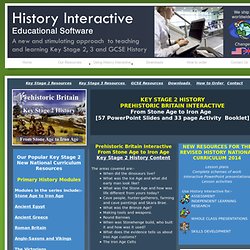
The Stone Age for Kids. Horrible Histories: The Stone Age report. Another cracker from the brilliant CBBC sketch show HORRIBLE HISTORIES: the complete history of cavemen in just a couple of minutes!
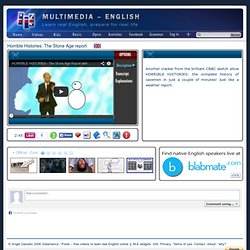
Just like a weather report. SAVAGE= /sævɪdʒ/ Wild, uncontrolled. CAVEMAN= Men living in caves. STAGE= Phase, part of a process. THE STONE AGE REPORT= It is a parody of the weather report (or weather forecast) but talking about the Stone Age. BELIEVE IT OR NOT= We use this expression when we are going to say something shocking, hard to believe, but we assure it’s true.
PLENTY= A lot, more than enough. 6 FOOT 1= 1 foot = 0.305 metres, so 6.1 feet is 1.86 ms. HE IS TONS OF FUN= He is great fun, it’s a lot of fun with him. HARD AS NAILS= A common expression meaning “very hard”, very tough, strong. We’re here to help teach Stone Age to Iron Age Britain. Teachers are facing a lot of changes at the moment.
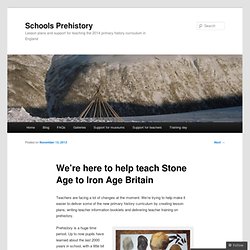
We’re trying to help make it easier to deliver some of the new primary history curriculum by creating lesson plans, writing teacher information booklets and delivering teacher training on prehistory. A selection of stone tools from the Stone Age Prehistory is a huge time period. Up to now pupils have learned about the last 2000 years in school, with a little bit about Ancient Egypt and/or Greece thrown in to take it back maybe to about 3000 BC. This is a tiny percentage of the immensity of human history, which stretches back a couple of million years and in Britain, about 850,000 years. A Day in the Life Of A 10-Year-Old in Ancient Britain - Hands on History - BBC. Hands-on History for Schools. Stone Age People The New Stone Age or Neolithic (which is Latin for New Stone Age) began with the start of farming and is round about when Britain became separate from Europe.
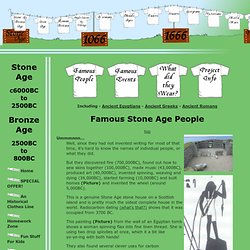
Stone Age poeple mainly wore animal skins which they sewed together with bone needles. They probably looked like this reconstruction of Ötzi the Iceman. His clothes are mostly made from goatskin, sewn together with strips of leather or tendons. He wears the fur on the inside, as this provides more warmth and resistance to rain. In northern counties, such as Britain, people discovered how to spin wool, while in more sotherly regions (such as Egypt) they grew a plant called flax which can be spun to make linen. Tools And The Stone Age - World History For Kids. Tools and the Stone Age One of the most important advancements in human history was the development and use of tools.

Tools allowed hominids to become the masters of their environments, to hunt, to build, and to perform important tasks that made life easier for them. Timeline British History for Kids - UK. Stone Age - Time Traveller Kids. The stone age lasted a very long time indeed.

From the very dawn of man three million years ago, to the farmers of a few thousand years ago. It is called the stone age as you might have guessed, because the people used tools made of stone. To make it easier to talk about archaeologists have divided the stone age into three main time periods: Timeline British History for Kids - Uk. Hands on History - Ancient Britain: Activities for Families and Groups. Mesolithic.
In archeology, mesolithic (Greek: mesos "middle", lithos "stone") is the culture between paleolithic and neolithic.
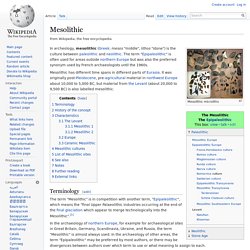
The term "Epipaleolithic" is often used for areas outside northern Europe but was also the preferred synonym used by French archaeologists until the 1960s. Mesolithic has different time spans in different parts of Eurasia. It was originally post-Pleistocene, pre-agricultural material in northwest Europe about 10,000 to 5,000 BC, but material from the Levant (about 20,000 to 9,500 BC) is also labelled mesolithic. Terminology[edit] The term "Mesolithic" is in competition with another term, "Epipaleolithic", which means the "final Upper Palaeolithic industries occurring at the end of the final glaciation which appear to merge technologically into the Mesolithic".[1] In the archaeology of northern Europe, for example for archaeological sites in Great Britain, Germany, Scandinavia, Ukraine, and Russia, the term "Mesolithic" is almost always used. Ireland in the last Ice Age.
View a summary of this chapter Ireland owes the physcal shape of its landscape almost entirely to the actions of the last Ice Age.
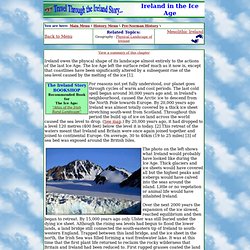
The Ice Age left the surface relief much as it now is, except that coastlines have been significantly altered by a subsequent rise of the sea-level caused by the melting of the ice [1]. For reasons not yet fully understood, our planet goes through cycles of warm and cool periods. The last cold spell began around 30,000 years ago and, in Ireland's neighbourhood, caused the Arctic ice to descend from the North Pole towards Europe. By 20,000 years ago Ireland was almost totally covered by a thick ice sheet stretching south-west from Scotland. Examining the Genes of Stone Age Farmers. Osteologists Ove and Evy Persson during the excavation of Grave 2 at Ajvide, Gotland, Sweden, in 1983. The skeleton belongs to a young female, c. 20 years of age, dated to around 2700 BC. Photograph: Photo: Göran Burenhult.